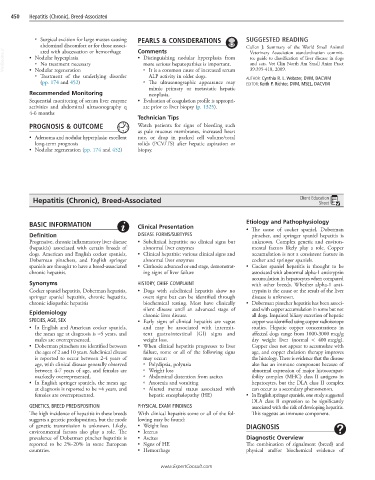Page 920 - Cote clinical veterinary advisor dogs and cats 4th
P. 920
450 Hepatitis (Chronic), Breed-Associated
○ Surgical excision for large masses causing PEARLS & CONSIDERATIONS SUGGESTED READING
abdominal discomfort or for those associ- Comments Cullen J: Summary of the World Small Animal
VetBooks.ir • Nodular hyperplasia • Distinguishing nodular hyperplasia from tee guide to classification of liver disease in dogs
ated with abscessation or hemorrhage
Veterinary Association standardization commit-
more serious hepatopathies is important.
and cats. Vet Clin North Am Small Anim Pract
○ No treatment necessary
39:395-418, 2009.
• Nodular regeneration
ALP activity in older dogs.
○ Treatment of the underlying disorder ○ It is a common cause of increased serum AUTHOR: Cynthia R. L. Webster, DVM, DACVIM
(pp. 174 and 452) ○ The ultrasonographic appearance may EDITOR: Keith P. Richter, DVM, MSEL, DACVIM
mimic primary or metastatic hepatic
Recommended Monitoring neoplasia.
Sequential monitoring of serum liver enzyme • Evaluation of coagulation profile is appropri-
activities and abdominal ultrasonography q ate prior to liver biopsy (p. 1325).
4-6 months
Technician Tips
PROGNOSIS & OUTCOME Watch patients for signs of bleeding such
as pale mucous membranes, increased heart
• Adenoma and nodular hyperplasia: excellent rate, or drop in packed cell volume/total
long-term prognosis solids (PCV/TS) after hepatic aspiration or
• Nodular regeneration (pp. 174 and 452) biopsy.
Hepatitis (Chronic), Breed-Associated Client Education
Sheet
BASIC INFORMATION Clinical Presentation Etiology and Pathophysiology
• The cause of cocker spaniel, Doberman
Definition DISEASE FORMS/SUBTYPES pinscher, and springer spaniel hepatitis is
Progressive, chronic inflammatory liver disease • Subclinical hepatitis: no clinical signs but unknown. Complex genetic and environ-
(hepatitis) associated with certain breeds of abnormal liver enzymes mental factors likely play a role. Copper
dogs. American and English cocker spaniels, • Clinical hepatitis: various clinical signs and accumulation is not a consistent feature in
Doberman pinschers, and English springer abnormal liver enzymes cocker and springer spaniels.
spaniels are thought to have a breed-associated • Cirrhosis: advanced or end stage, demonstrat- • Cocker spaniel hepatitis is thought to be
chronic hepatitis. ing signs of liver failure associated with abnormal alpha-1 antitrypsin
accumulation in hepatocytes when compared
Synonyms HISTORY, CHIEF COMPLAINT with other breeds. Whether alpha-1 anti-
Cocker spaniel hepatitis, Doberman hepatitis, • Dogs with subclinical hepatitis show no trypsin is the cause or the result of the liver
springer spaniel hepatitis, chronic hepatitis, overt signs but can be identified through disease is unknown.
chronic idiopathic hepatitis biochemical testing. Most have clinically • Doberman pinscher hepatitis has been associ-
silent disease until an advanced stage of ated with copper accumulation in some but not
Epidemiology chronic liver disease. all dogs. Impaired biliary excretion of hepatic
SPECIES, AGE, SEX • Early signs of clinical hepatitis are vague copper was identified using copper radioisotope
• In English and American cocker spaniels, and may be associated with intermit- studies. Hepatic copper concentrations in
the mean age at diagnosis is ≈5 years, and tent gastrointestinal (GI) signs and affected dogs range from 1000-3000 mcg/g
males are overrepresented. weight loss. dry weight liver (normal < 400 mcg/g).
• Doberman pinschers are identified between • When clinical hepatitis progresses to liver Copper does not appear to accumulate with
the ages of 2 and 10 years. Subclinical disease failure, some or all of the following signs age, and copper chelation therapy improves
is reported to occur between 2-4 years of may occur: the histology. There is evidence that the disease
age, with clinical disease generally observed ○ Polydipsia, polyuria also has an immune component because of
between 4-7 years of age, and females are ○ Weight loss abnormal expression of major histocompat-
markedly overrepresented. ○ Abdominal distention from ascites ibility complex (MHC) class II antigens in
• In English springer spaniels, the mean age ○ Anorexia and vomiting hepatocytes, but the DLA class II complex
at diagnosis is reported to be ≈4 years, and ○ Altered mental status associated with can occur as a secondary phenomenon.
females are overrepresented. hepatic encephalopathy (HE) • In English springer spaniels, one study suggested
DLA class II expression to be significantly
GENETICS, BREED PREDISPOSITION PHYSICAL EXAM FINDINGS associated with the risk of developing hepatitis.
The high incidence of hepatitis in these breeds With clinical hepatitis some or all of the fol- This suggests an immune component.
suggests a genetic predisposition, but the mode lowing may be found:
of genetic transmission is unknown. Likely, • Weight loss DIAGNOSIS
environmental factors also play a role. The • Icterus
prevalence of Doberman pincher hepatitis is • Ascites Diagnostic Overview
reported to be 2%-20% in some European • Signs of HE The combination of signalment (breed) and
countries. • Hemorrhage physical and/or biochemical evidence of
www.ExpertConsult.com

